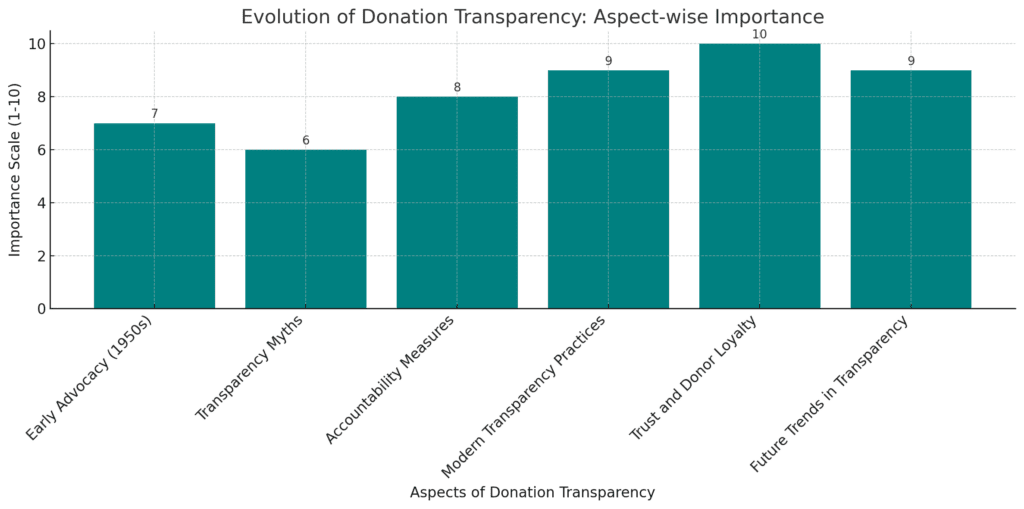The History of Donation Transparency in Philanthropy
Key Takeaways
| Aspect | Description |
|---|---|
| Importance of Transparency | Transparency is crucial in philanthropy for building trust and ensuring accountability. |
| Historical Milestones | Traces the development of transparency from its early advocacy in the 1950s to present-day practices. |
| Modern Practices | Highlights current transparency practices, including the use of technology and data-driven strategies. |
| Building Trust and Loyalty | Explains how transparency fosters long-term donor relationships and enhances nonprofit credibility. |
Introduction
Donation transparency has become a cornerstone in the realm of philanthropy. It’s a concept that resonates deeply with the ethos of accountability and trust between donors and nonprofit organizations. In the modern landscape of charitable giving, where every dollar counts and every donor’s intention is crucial, the transparency of donations not only builds confidence but also strengthens the bond between the giver and the receiver.
Historical Roots of Transparency in Philanthropy
The journey towards transparency in philanthropy began in earnest during the mid-20th century. A pivotal moment occurred in 1952 when Russell Leffingwell, chair of Carnegie Corporation’s board of trustees, championed the idea of foundations having “glass pockets.” This metaphor underscored the need for public accountability in philanthropy, especially as distrust among politicians and citizens grew towards organizations operating with little regulation. This era marked the beginning of a transformation in how philanthropic entities viewed and practiced openness about their financial dealings.
Dispelling Donation Myths
Amidst the evolving landscape of donation transparency, numerous myths have emerged, clouding public perception. It’s essential to debunk these myths to foster a clearer understanding of how transparency truly operates in the philanthropic sector. Addressing misconceptions ensures that the core values of transparency are not only upheld but also effectively communicated to both donors and the public at large.
The Growth and Importance of Transparency
Over the decades, the call for transparency has not just persisted but intensified. It has evolved from a mere ethical practice to a strategic imperative in the philanthropic world. Transparency is no longer a luxury but a necessity for building and maintaining donor trust. It has become integral in reassuring donors that their contributions are being used effectively and ethically.
Building Nonprofit Accountability
Nonprofit organizations are increasingly recognizing the importance of accountability as a key component of their operations. This shift towards greater openness and clarity in financial dealings is critical in building lasting relationships with donors. Implementing robust accountability measures ensures that nonprofits not only comply with regulatory standards but also align closely with the expectations of their benefactors.
Modern Practices in Donation Transparency
With the advent of technology and an increasingly informed donor base, modern practices in donation transparency have evolved significantly. Nonprofits today are leveraging various tools and platforms to provide real-time insights into their operations and the impact of donations. This section explores current trends and technological advancements that have reshaped transparency in philanthropy.
Key Practices
- Real-Time Reporting: Utilization of digital platforms for immediate reporting on how funds are being used.
- Data-Driven Strategies: Employing analytics to understand donor behaviors and tailor communication.
- Online Transparency Portals: Creating dedicated sections on websites for financial disclosures and impact reports.
Nonprofit Impact Tracking
The ability to track and demonstrate the impact of donations is crucial in today’s philanthropic environment. Nonprofits are now more than ever focused on showing tangible results of their work. Impact tracking involves:
- Quantitative Measurements: Reporting on specific metrics related to program outcomes.
- Qualitative Assessments: Sharing stories and testimonials that illustrate the human impact of donations.
- Technology Integration: Using software solutions to streamline and enhance impact reporting processes.
The Benefits of Being Transparent
Transparency in the nonprofit sector is not just about adhering to ethical standards; it has tangible benefits that significantly enhance an organization’s effectiveness and sustainability. These benefits include:
Advantages of Transparency
- Increased Donor Confidence: Transparency builds trust, encouraging more frequent and larger donations.
- Improved Accountability: It ensures that funds are utilized as intended, promoting responsible financial management.
- Enhanced Cribility: Transparent practices bolster an organization’s reputation and attract more support.
Strengthening Donor Trust
Establishing and maintaining donor trust is a cornerstone of successful philanthropy. Transparent practices are essential in forging these trust-based relationships. Key strategies for strengthening donor trust through transparency include:
- Regular Communication: Keeping donors informed about organizational activities and fund usage.
- Open Financial Reporting: Sharing detailed financial statements and audits with donors.
- Engaging Donor Feedback: Inviting donors to provide input and feedback on projects and initiatives.
Conclusion: The Future of Philanthropy and Transparency

As we look towards the future, the role of transparency in philanthropy is set to become even more pivotal. The evolving landscape of charitable giving, coupled with advancements in technology, indicates a trend towards even greater openness and accountability. This concluding section encapsulates the importance of donation transparency in shaping the future of philanthropy.
Future Trends
- Adoption of Advanced Technologies: Incorporating AI and blockchain for enhanced transparency and efficiency.
- Increased Donor Engagement: Fostering a culture of open dialogue and participation with donors.
- Global Standards for Transparency: Development and adoption of universal transparency standards across the nonprofit sector.
Donation Transparency Trust
Donation Transparency Trust represents the commitment to uphold the highest standards of transparency in philanthropy. It’s a testament to the belief that trust and openness are key to achieving meaningful impact in the charitable world. The Trust focuses on:
- Ethical Fund Management: Ensuring that every donation is managed and allocated with the utmost integrity.
- Transparent Communication: Regularly updating donors about fund utilization and project outcomes.
- Building Long-term Relationships: Creating a sustainable bond with donors based on mutual trust and respect.
Additional Resources
- About Us: Learn more about our mission and commitment to transparency in philanthropy.
- Contact Us: Get in touch for more information or to join our cause.
- Author Profile: Explore articles and insights from our team of experts.
Reinforcing the Pillars of Trust and Accountability
The journey of donation transparency is an ongoing one, with each step reinforcing the pillars of trust and accountability in the philanthropic sector. As we embrace new challenges and opportunities, the commitment to transparent practices remains a steadfast goal for organizations dedicated to making a difference. This commitment is not just about meeting standards but about nurturing a culture of openness that resonates with every stakeholder involved.
Embracing a Transparent Future
The future of philanthropy is intrinsically linked to how effectively organizations can maintain transparency. This is not just a matter of regulatory compliance but a strategic approach that can significantly elevate an organization’s ability to make a lasting impact. Embracing transparency is, therefore, not just a choice but a necessity in the journey towards a more accountable and trustworthy philanthropic environment.
Looking Ahead
- Innovative Transparency Tools: Exploring new tools and platforms to enhance transparency.
- Educational Initiatives: Educating donors and the public about the importance of transparency in philanthropy.
- Collaborative Efforts: Working together with other organizations to promote transparency standards.
Main Page
For more information on the importance of donation transparency and how it shapes the world of philanthropy, visit our main page. Discover a wealth of resources, insights, and stories that illustrate the power of transparency in creating a more just and equitable world.
Final Thoughts
The history of donation transparency is a testament to the evolving nature of philanthropy and the growing awareness of the need for openness and accountability. By understanding this history and embracing the practices that foster transparency, organizations can build stronger, more meaningful relationships with their donors and make a more significant impact on the causes they champion.











